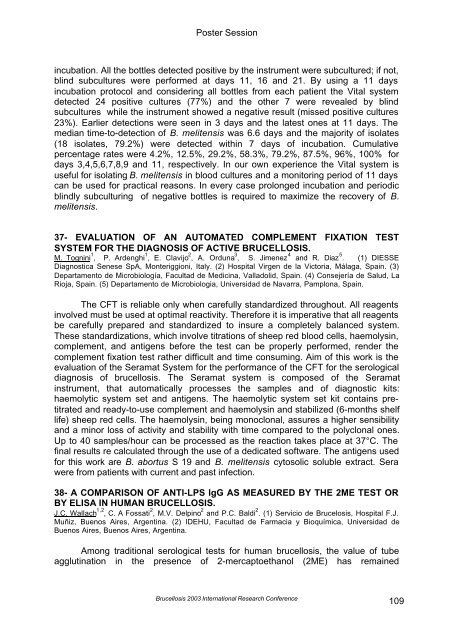Brucellosis 2003 proceedings - PHIDIAS
Brucellosis 2003 proceedings - PHIDIAS
Brucellosis 2003 proceedings - PHIDIAS
You also want an ePaper? Increase the reach of your titles
YUMPU automatically turns print PDFs into web optimized ePapers that Google loves.
Poster Session<br />
incubation. All the bottles detected positive by the instrument were subcultured; if not,<br />
blind subcultures were performed at days 11, 16 and 21. By using a 11 days<br />
incubation protocol and considering all bottles from each patient the Vital system<br />
detected 24 positive cultures (77%) and the other 7 were revealed by blind<br />
subcultures while the instrument showed a negative result (missed positive cultures<br />
23%). Earlier detections were seen in 3 days and the latest ones at 11 days. The<br />
median time-to-detection of B. melitensis was 6.6 days and the majority of isolates<br />
(18 isolates, 79.2%) were detected within 7 days of incubation. Cumulative<br />
percentage rates were 4.2%, 12.5%, 29.2%, 58.3%, 79.2%, 87.5%, 96%, 100% for<br />
days 3,4,5,6,7,8,9 and 11, respectively. In our own experience the Vital system is<br />
useful for isolating B. melitensis in blood cultures and a monitoring period of 11 days<br />
can be used for practical reasons. In every case prolonged incubation and periodic<br />
blindly subculturing of negative bottles is required to maximize the recovery of B.<br />
melitensis.<br />
37- EVALUATION OF AN AUTOMATED COMPLEMENT FIXATION TEST<br />
SYSTEM FOR THE DIAGNOSIS OF ACTIVE BRUCELLOSIS.<br />
M. Tognini 1 , P. Ardenghi 1 , E. Clavijo 2 , A. Orduna 3 , S. Jimenez 4 and R. Diaz 5 . (1) DIESSE<br />
Diagnostica Senese SpA, Monteriggioni, Italy. (2) Hospital Virgen de la Victoria, Málaga, Spain. (3)<br />
Departamento de Microbiología, Facultad de Medicina, Valladolid, Spain. (4) Consejería de Salud, La<br />
Rioja, Spain. (5) Departamento de Microbiologia, Universidad de Navarra, Pamplona, Spain.<br />
The CFT is reliable only when carefully standardized throughout. All reagents<br />
involved must be used at optimal reactivity. Therefore it is imperative that all reagents<br />
be carefully prepared and standardized to insure a completely balanced system.<br />
These standardizations, which involve titrations of sheep red blood cells, haemolysin,<br />
complement, and antigens before the test can be properly performed, render the<br />
complement fixation test rather difficult and time consuming. Aim of this work is the<br />
evaluation of the Seramat System for the performance of the CFT for the serological<br />
diagnosis of brucellosis. The Seramat system is composed of the Seramat<br />
instrument, that automatically processes the samples and of diagnostic kits:<br />
haemolytic system set and antigens. The haemolytic system set kit contains pretitrated<br />
and ready-to-use complement and haemolysin and stabilized (6-months shelf<br />
life) sheep red cells. The haemolysin, being monoclonal, assures a higher sensibility<br />
and a minor loss of activity and stability with time compared to the polyclonal ones.<br />
Up to 40 samples/hour can be processed as the reaction takes place at 37°C. The<br />
final results re calculated through the use of a dedicated software. The antigens used<br />
for this work are B. abortus S 19 and B. melitensis cytosolic soluble extract. Sera<br />
were from patients with current and past infection.<br />
38- A COMPARISON OF ANTI-LPS IgG AS MEASURED BY THE 2ME TEST OR<br />
BY ELISA IN HUMAN BRUCELLOSIS.<br />
J.C. Wallach 1,2 , C. A Fossati 2 , M.V. Delpino 2 and P.C. Baldi 2 . (1) Servicio de Brucelosis, Hospital F.J.<br />
Muñiz, Buenos Aires, Argentina. (2) IDEHU, Facultad de Farmacia y Bioquímica, Universidad de<br />
Buenos Aires, Buenos Aires, Argentina.<br />
Among traditional serological tests for human brucellosis, the value of tube<br />
agglutination in the presence of 2-mercaptoethanol (2ME) has remained<br />
<strong>Brucellosis</strong> <strong>2003</strong> International Research Conference<br />
109
















